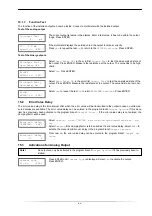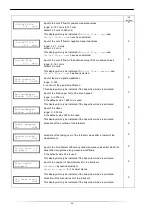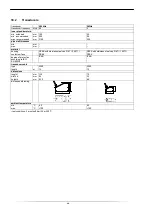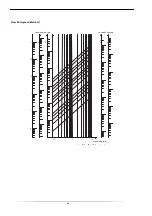
73
The measured values substantially differ from the expected values
• Wrong measured values are often caused by wrong parameters. Make sure that the entered parameters are correct for
the measuring point.
• If the parameters are correct, see section 16.5 for the description of typical situations in which wrong measured values
are obtained.
16.2
Selection of the Measuring Point
• Make sure that the recommended min. distance to any disturbance source is observed (see chapter 5, Tab. 5.2).
• Avoid measuring points with deposit formation in the pipe.
• Avoid measuring points in the vicinity of deformations and defects on the pipe and in the vicinity of welds.
• Measure the temperature at the measuring point and make sure that the transducers are suitable for this temperature.
• Make sure that the outer pipe diameter is within the measuring range of the transducers.
• When measuring on a horizontal pipe, the transducers have to be mounted on the side of the pipes.
• A vertical pipe always has to be filled at the measuring point and the medium should flow upward.
• No gas bubbles should form (even bubble-free media can form gas bubbles when the medium expands, e.g., upstream
of pumps and downstream of great cross-section enlargements).
16.3
Maximum Acoustic Contact
Observe the instructions in chapter 7.
16.4
Application Specific Problems
The entered sound speed of the medium is wrong
The entered sound speed is used to calculate the transducer distance and is therefore very important for the transducer
positioning. The sound speeds stored in the transmitter only serve as orientation.
The entered pipe roughness is not appropriate
Check the entered value. The state of the pipe should be taken into account.
Measurements on porous pipe materials (e.g., concrete or cast iron) are only possible under certain conditions
Contact SEBAKMT.
The pipe lining may cause problems during the measurement if it is not firmly attached to the inner pipe wall or
consists of an acoustically absorbing material
Try measuring on a liner free section of the pipe.
Highly viscous media strongly attenuate the ultrasonic signal
Measurements on media with a viscosity > 1000 mm²/s are only possible under certain conditions.
A higher proportion of gas bubbles or solids in the medium scatter and absorb the ultrasonic signal and there-
fore attenuate the measuring signal
A measurement is impossible if the value is
≥
10 %. If the proportion is high, but < %, a measurement is only possible un-
der certain conditions.
The flow is in the transition range between laminar and turbulent flow where flow measurement is difficult
Calculate the Reynolds number of the flow at the measuring point with the program FluxFlow (free download: www.flex-
im.com). Contact SEBAKMT.
16.5
Large Deviations of the Measured Values
The entered sound speed of the medium is wrong
A wrong sound speed can result in the ultrasonic signal that is reflected directly on the pipe wall being mistaken for the
measuring signal that has passed through the medium. The flow calculated on the basis of the wrong signal by the trans-
mitter is very small or fluctuates around zero.
There is gas in the pipe
If there is gas in the pipe, the measured flow will always be too high because both the gas volume and the liquid volume
are measured.
















































